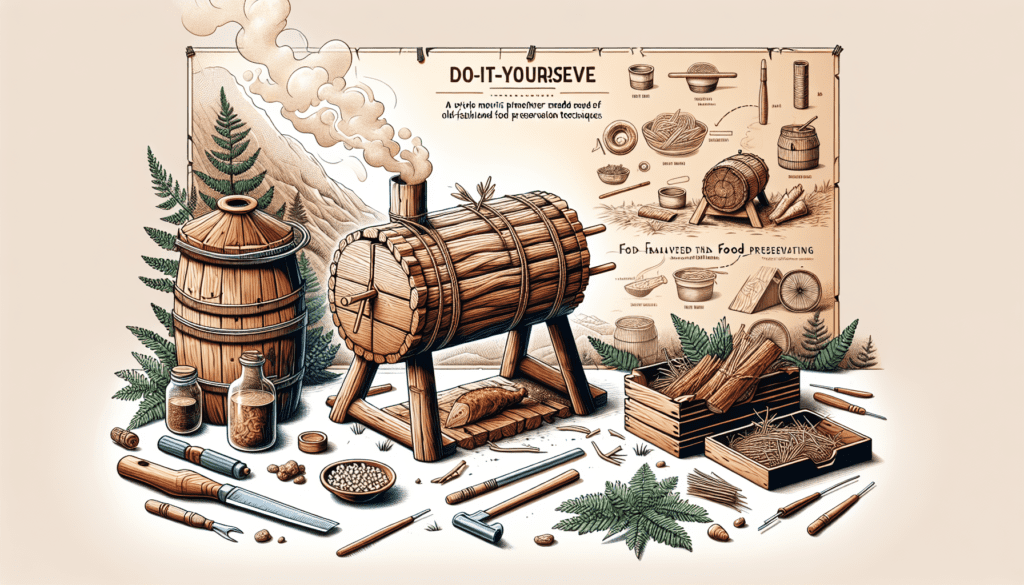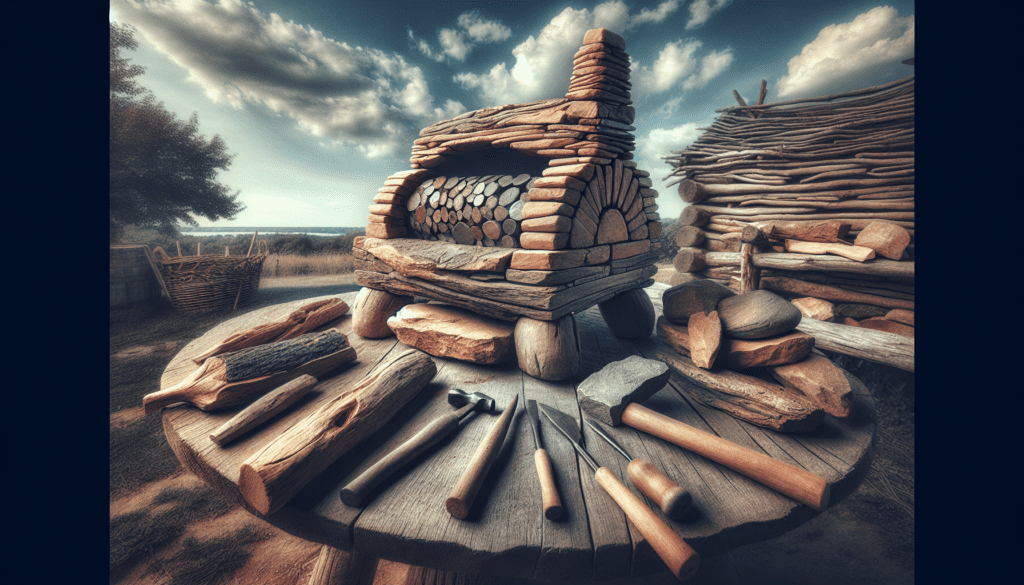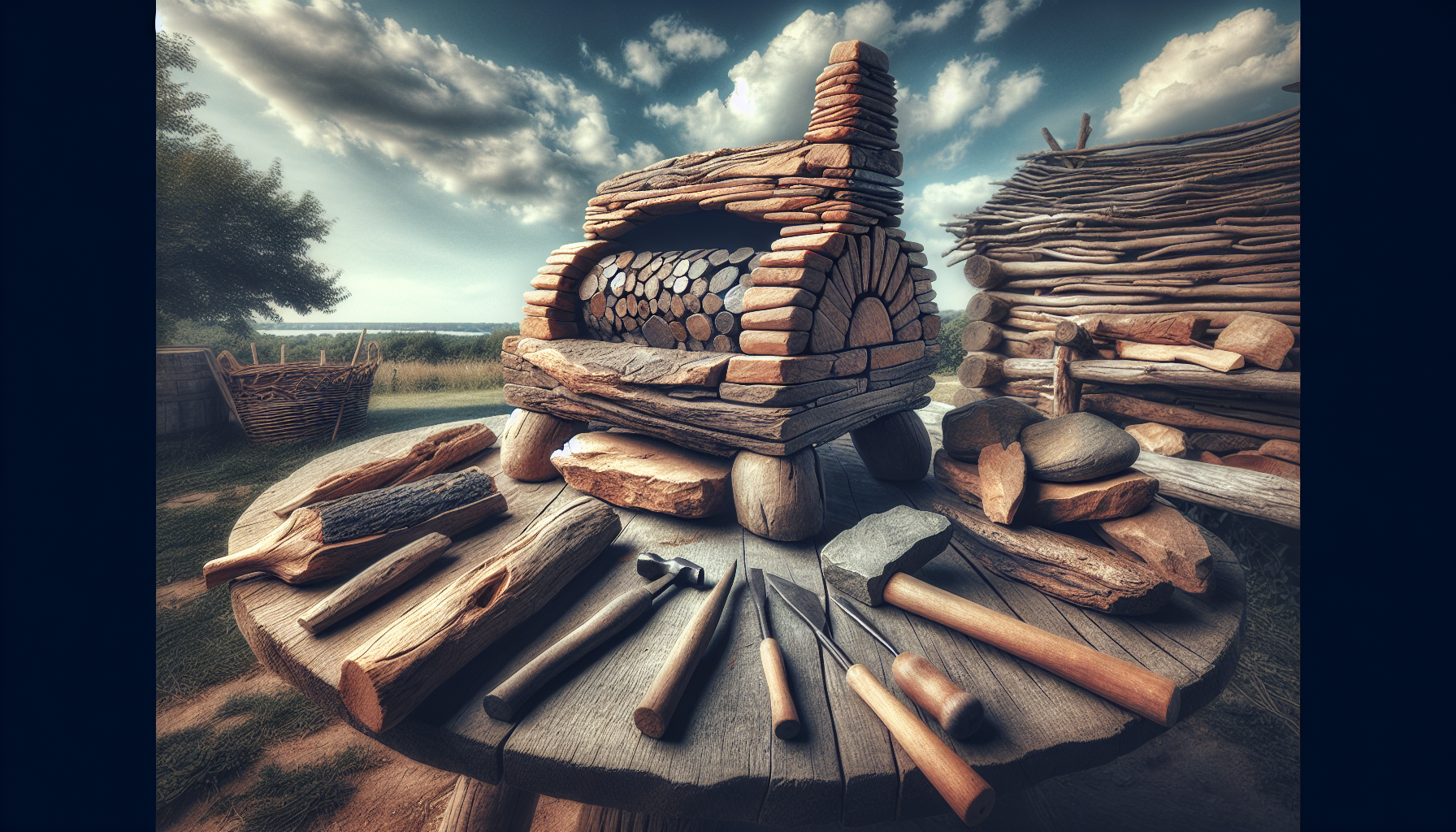Have you ever wanted to preserve your food in a traditional, rustic way? Look no further! This article will guide you through the process of building a primitive smoker for food preservation. With simple materials and step-by-step instructions, you’ll be able to enhance the flavor of your favorite meats, fish, and even vegetables, while also keeping them fresh for longer periods of time. Say goodbye to artificial preservatives and hello to the art of smoking!

Materials and Tools
Choosing the Right Materials
When it comes to building a primitive smoker for food preservation, it’s important to select the right materials that are both durable and heat-resistant. One of the most commonly used materials for building the smoker is brick or stone. These materials not only provide excellent insulation but also retain heat effectively. Another option is using metal sheets, which are easier to work with and provide a more portable solution.
Additionally, you will need to consider the type of wood you will use for the firebox and smoking process. Hardwoods such as oak or hickory are great choices as they produce a rich smoky flavor. It’s important to avoid using woods with high resin content, as they can leave an unpleasant taste on the food.
Essential Tools
To successfully build a primitive smoker, you will need a few essential tools. These include a shovel or spade for digging the foundation, a level for ensuring a level surface, a hammer for securing materials, and a chisel or masonry saw for cutting bricks or stones if necessary. It’s also helpful to have a tape measure, a pencil, and safety equipment such as gloves and safety goggles.
Selecting a Location
Considerations for Location
Choosing the right location for your primitive smoker is crucial for safety and functionality. The location should be well-ventilated, away from any combustible materials, and protected from the wind. It’s also important to ensure that the smoker is not placed too close to any structures or trees to avoid the risk of fire spreading.
Furthermore, consider the convenience of the location. Ideally, it should be easily accessible for adding wood to the firebox and monitoring the smoking process. You may also want to choose a location that offers some privacy, as smoking food can sometimes take several hours or even days.
Safety Precautions
When selecting a location for your primitive smoker, it’s important to take safety precautions into account. Ensure that the smoker is positioned on a fire-resistant surface, such as concrete or gravel, to minimize the risk of accidental fires. It’s also essential to have a fire extinguisher nearby and a clear path for escape in case of emergencies.
Before starting the smoking process, make sure to check local fire regulations and obtain any necessary permits if required. Safety should always be the top priority when it comes to building and operating a primitive smoker.
Preparing the Ground
Clearing the Area
Before you start building the smoker, it’s important to clear the area of any debris, vegetation, or other obstacles that may hinder the construction process. Use a shovel or spade to remove grass, rocks, and any other unwanted materials from the area where the smoker will be placed. This will ensure a clean and even surface for building the smoker.
Leveling the Surface
Once the area is cleared, it’s time to level the surface. A level surface is essential for the stability and functionality of the smoker. Use a level tool to check if the ground is even. If the ground is not level, you can use a shovel to dig out any high spots or add soil to fill in any low areas.
Taking the time to prepare the ground properly will help ensure that your primitive smoker stands firm and functions optimally throughout the smoking process.
Constructing the Base
Choosing a Base Design
The base of your primitive smoker provides stability and supports the weight of the smoke chamber. There are several base designs to choose from, including a simple concrete slab, a brick or stone base, or even repurposing an old grill or metal frame.
When selecting a base design, consider the overall size and weight of the smoke chamber, as well as the materials you plan to use for construction. Ensure that the base is sturdy and able to withstand extreme heat and weather conditions.
Laying the Foundation
Once you have chosen the base design, it’s time to lay the foundation. If you opt for a concrete slab, dig a trench around the perimeter of the area and fill it with concrete. Smooth the surface with a trowel and allow it to dry and cure according to the manufacturer’s instructions.
If you are using bricks or stones, lay them in a pattern that provides stability and allows for proper airflow. Use a level tool to ensure that the base is even and secure.
Building a solid and durable base will provide a strong foundation for the rest of your primitive smoker.

Building the Smoke Chamber
Determining the Size
The size of your smoke chamber will depend on the amount of food you intend to smoke and the available space. It’s important to strike a balance between the capacity of the smoker and its functionality. A smoke chamber that is too small may not be able to accommodate large cuts of meat, while a chamber that is too large may result in heat and smoke dispersion issues.
Consider your specific needs and the amount of food you plan to smoke regularly before determining the size of your smoke chamber.
Constructing Walls and Roof
Once you have determined the size of the smoke chamber, it’s time to construct the walls and roof. If using bricks or stones, carefully stack them on the base, ensuring that they are securely connected using a heat-resistant mortar.
If you are using metal sheets, you can create a frame using angle iron or square tubing and attach the sheets to it. Make sure to seal any gaps or joints with high-temperature silicone to prevent heat and smoke leakage.
Remember to leave openings for vents and doors to regulate airflow and access your food during the smoking process.
Creating Airflow
Importance of Ventilation
Proper airflow is crucial for maintaining consistent temperatures and even distribution of smoke within the smoke chamber. Without adequate ventilation, you may encounter issues such as uneven cooking or even the risk of fire.
To ensure proper ventilation, it’s important to incorporate air vents into your primitive smoker design. These vents will allow air to flow into the firebox, where it will provide oxygen to sustain the fire, and then circulate throughout the smoke chamber, distributing heat and smoke evenly.
Designing Air Vents
When designing your primitive smoker, determine the number and size of air vents based on the size of the smoke chamber and the desired airflow. Typically, vents are placed near the firebox and on the opposite side of the smoke chamber to create airflow.
You can use metal dampers or adjustable vents to control the airflow and regulate the temperature within the smoker. Experiment with the position and size of the vents to find the optimal configuration for your smoking needs.
Installing the Firebox
Choosing an Appropriate Firebox
The firebox is an essential component of your primitive smoker as it provides the heat necessary for smoking the food. When choosing a firebox, consider its size, material, and heat retention capabilities.
An ideal firebox should be made of thick and heat-resistant metal, such as steel or cast iron. It should have enough capacity to hold an adequate amount of wood or charcoal for the smoking process. Additionally, ensure that the firebox is easily accessible for adding fuel and monitoring the fire.
Connecting Firebox to Smoke Chamber
To connect the firebox to the smoke chamber, create an opening in the wall of the smoke chamber near the bottom. This opening should be large enough to allow smoke and heat to pass from the firebox into the smoke chamber.
You can use a metal pipe or chimney to connect the firebox to the smoke chamber. Position the pipe in a way that promotes airflow and ensures that smoke is expelled efficiently. Secure the pipe in place using high-temperature silicone or other heat-resistant materials.
Properly installing the firebox and connecting it to the smoke chamber is crucial for achieving the desired smoking results.
Creating Smoking Racks
Choosing Rack Material
Smoking racks are responsible for holding the food during the smoking process. It’s important to choose the right material for the racks to ensure safety and optimal performance.
Stainless steel or food-grade wire mesh are commonly used for smoking racks. These materials are sturdy, easy to clean, and resistant to heat and corrosion. Ensure that the chosen material can support the weight of the food without bending or breaking.
Determining Rack Placement
The placement of smoking racks within the smoke chamber is critical for even smoking results. Ideally, the racks should be positioned in a way that allows for proper airflow and consistent heat distribution.
Consider the size and shape of the food you plan to smoke when determining the distance between the racks. Leave enough space between them to allow smoke and heat to circulate freely, ensuring that each piece of food is exposed to the smoke evenly.
Adding Insulation
Types of Insulation
Insulating your smoke chamber is essential for maintaining consistent temperatures and minimizing heat loss. There are several types of insulation materials available, including fiberglass, ceramic fiber, and rockwool.
Fiberglass insulation is commonly used as it is affordable and readily available. Ceramic fiber insulation offers excellent heat resistance and is often used in high-temperature applications. Rockwool insulation provides efficient heat retention and is resistant to moisture.
Choose the type of insulation that best suits your needs and the level of heat you expect to generate within the smoke chamber.
Applying Insulation to Smoke Chamber
To apply insulation to the smoke chamber, carefully adhere the chosen insulation material to the walls and roof of the smoke chamber. Ensure that the insulation material is applied evenly and tightly secured to prevent any gaps or leaks.
Follow the manufacturer’s instructions for installation and pay attention to any safety precautions, such as wearing gloves and a mask, as insulation materials can be irritating to the skin and lungs.
Adding insulation will help maximize heat retention and maintain consistent temperatures throughout the smoking process.
Finishing Touches
Sealing Gaps and Leaks
Before you start using your primitive smoker, it’s important to thoroughly inspect the smoke chamber for any gaps or leaks. Even small gaps can compromise the smoking process and result in heat and smoke loss.
Use high-temperature silicone or heat-resistant caulk to seal any gaps or joints in the smoke chamber. Pay special attention to areas around vents, doors, and connections between different components.
Taking the time to seal any gaps and leaks will ensure that your primitive smoker operates efficiently and produces consistent smoking results.
Painting the Smoker
While not essential for functionality, painting your primitive smoker can enhance its appearance and protect it from the elements. Choose a high-temperature paint that is specifically designed for use on metal surfaces.
Before painting, clean the surface of the smoker thoroughly and remove any dirt, grease, or rust. Apply several coats of paint, allowing each coat to dry completely before applying the next.
Painting your smoker not only adds a personal touch but also helps to extend its lifespan and maintain its aesthetic appeal for years to come.
In conclusion, building a primitive smoker for food preservation requires careful consideration of materials, tools, location, and construction techniques. By following the guidelines provided in this comprehensive guide, you can create a functional and efficient smoker that will allow you to enjoy the flavors of smoked food while preserving it for longer periods. Remember to prioritize safety throughout the construction process and to experiment with different smoking techniques and recipes to achieve the desired results. Happy smoking!

